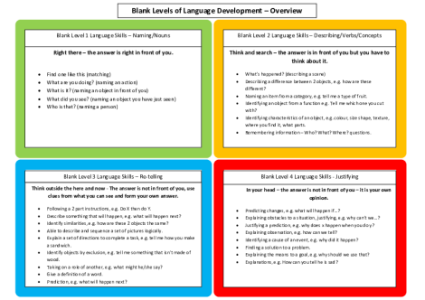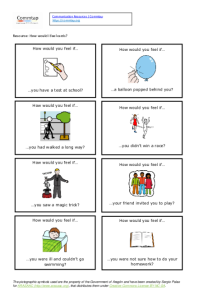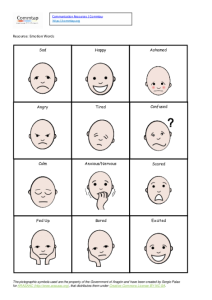Search
User login
Topic “Feelings/emotions”
Developing the skills to understand and express different emotions
| Activity/strategy name and materials required | How to do the activity | Key principles for doing the activity and comments |
|---|---|---|
| Talking about different emotions - Photographs of different people showing different emotions - you could get these from magazines, newspapers or by internet search. - Emotion symbols - click here to print. - Paper and pens | 1. Look through the photographs together - talk about what feelings or emotions the person is showing - you may have different answers from each other. Talk about why they may be showing emotions. 2. Can you match the symbols to the emotions. Talk about the differences you notice in peoples' faces. 3. Can you think of times when you felt this emotion - use the paper and pens to write this down. Compare your experiences. | You may want to start with basic emotion words such as happy, sad, cross and excited, before introducing more complex emotion words. |
| Feeling Dictionary - Exercise book/note pad/sheets of paper - Emotion symbols - click here to print. You can draw your own if you prefer. | Definitions: Happy: This is when I feel good about something. I might smile or laugh. Sad: This is when I don't feel good about something. I might cry. I might show I feel this way by being cross. Angry / cross: This is what I feel when something is not fair, or is bad. I might feel like shouting or punching or doing something to someone. Bored: This is when I'm not interested in what is happening, and just want it to finish. I might sigh, or lean my head on my hand. Upset: I might feel like this when something is not fair, or when someone is unkind. I might cry, or feel like shouting. Frightened / scared: This is what I might feel if I don't know what is happening, or if I am unsafe. I might cry, or scream, or just try not to move. I might want to find someone I know, like my mum or my teacher. Surprised: this is what I feel when something good happens that I didn't expect. I might smile, open my eyes wide, and say something like 'wow'! Excited: This is what I feel when I know something good is going to happen soon. I might smile, move around, and keep thinking about what is going to happen. | |
| If you're happy and you know it... - Emotion symbols (click here to print)or feelings Dictionary (see above) - Time-line of a day | You could choose a different feeling each day to work through the timeline. You could also display the timeline, and encourage the child / children to identify how they are feeling at different parts of the day. |
Say how you would feel in situations
| Activity/strategy name and materials required | How to do the activity | Key principles for doing the activity and comments |
|---|---|---|
| How would you feel if?: - Pictures/photos of different emotions - a printable set of emotion cards are available here. | 1. Print and cut out the resources. 2. Introduce the activity by having a quick discussion of how it's fine if different people feel differently about the same situation. 3. Take turns to choose a situation card and discuss it together. See if you can match how you would feel to the emotions symbols or pictures. 4. Some children may be able to explain why they'd feel that way e.g. "I'd be scared if I saw a spider because I don't like them'. | Reinforce the idea that there's no 'right' answer. |
To be able to display and interpret different emotions
| Activity/strategy name and materials required | How to do the activity | Key principles for doing the activity and comments |
|---|---|---|
| Emotions game Group game for a minimum of three people
| 1. Shuffle the emotions cards and put one face up in each of the spaces on the 1-6 grid. 2. Check the children/young person know what each card says and what the emotion is (remove any that are too difficult and put new cards in their place). 3. Let everyone choose a coloured counter. Everyone puts one of their counters on the “start”. 4. Choose one person to start (perhaps the adult should go first). 5. The person who starts shakes the dice in the cup, and puts the cup upside down on the table. Carefully lift up the cup and look at the dice so only you know which number is on top. Look at the emotions cards on the board to see which emotion corresponds to the number on the dice – but don’t say what it is. 6. Pick a phrase card. Read the phrase on the card, displaying the emotion you have been given. Use your voice and gestures. It’s fine to give children help in reading what the phrase is, but not in how to display the emotion! 7. The other players watch the player acting out the emotion. They decide which of the emotions the player is portraying. They put their other counter on the name of the emotion they have chosen. 8. When everyone has voted, the player who acted the emotion lifts up the cup to show which number was on the dice. 9. Check to see who chose the correct emotion. The people who chose correctly move their counter on to the next space 10. The player who acted also moves their counter on the same number of orange spaces as the number of people who guessed correctly. 11. The next player then has a turn to act. Continue until someone has reached the “finish” space. | This game rewards your child/young person for doing good acting as well as good interpreting; therefore, there is an incentive to display the emotion correctly. Using the coloured counters to "vote" for an emotion prevents people from changing their mind. If the game takes too long to play, use only the orange spaces on the board. |
Support Commtap to keep it online
Thank you for visiting Commtap.
Please read this message as it is extremely important.
- Visitor donations mean we can continue to host over 1,000 free activities to support speech, language, and communication development.
- Visitor donations mean we can continue to provide free resources to address a wide range of communication needs, including limited speech or language, interaction challenges, and needs associated with conditions such as developmental language disorder, autism, and cerebral palsy.
- Visitor donations mean we can continue to provide resources to support the work of speech and language therapists, teachers, teaching assistants, parents, and carers.
- Visitor donations mean we can continue to provide the free key word sign dictionary (bks.org.uk) which has over 2,000 Makaton and Signalong signs.
We know that not everyone is able to afford to pay to access these resources, however, if you can, please make a donation to keep the site going.
Thank you
Google ads on this page are provided by Google Adsense - and their presence does not imply any endorsement by Commtap. Report a problem with an ad on this page. Log in (for free) to avoid seeing Google ads.



